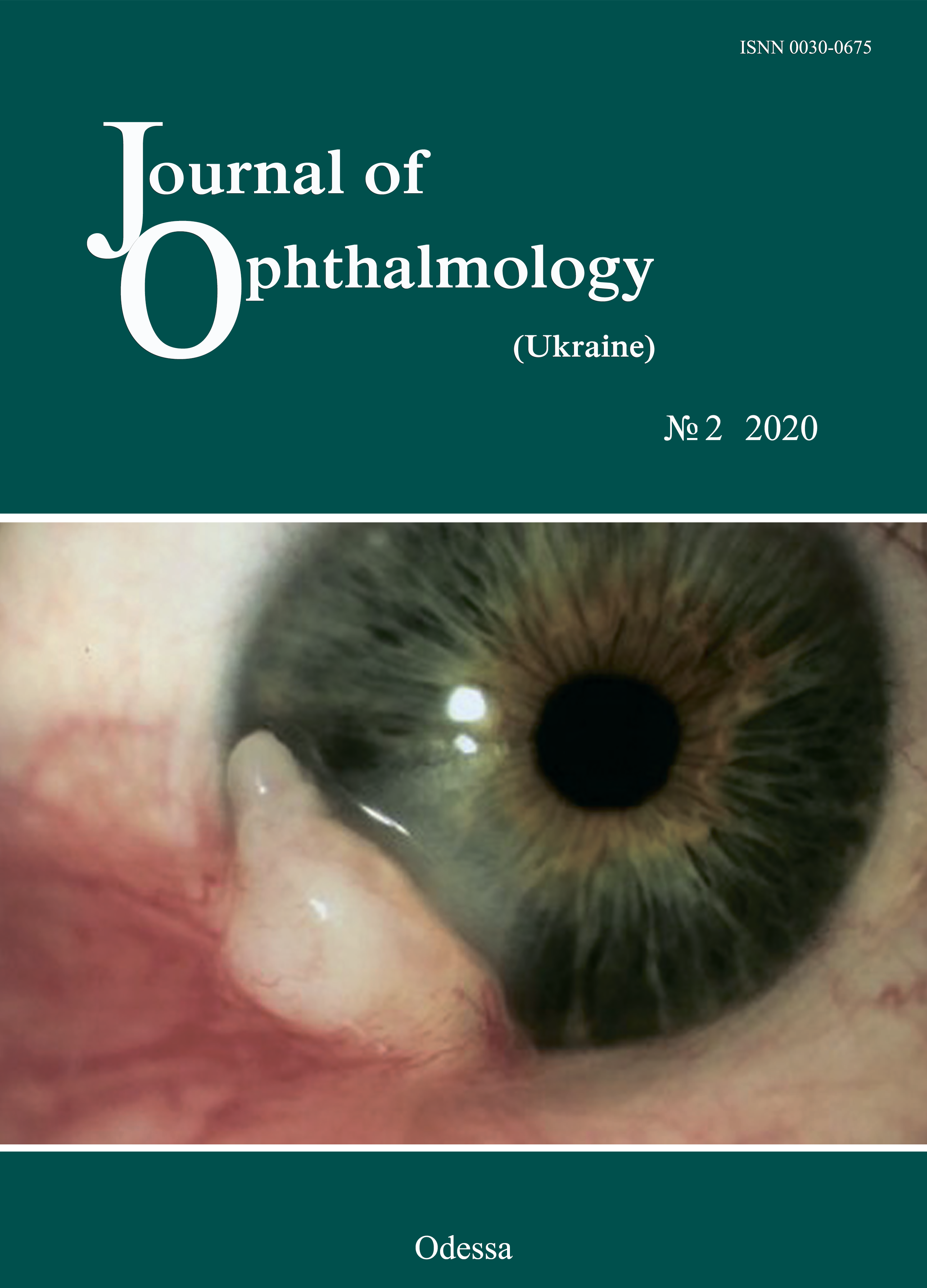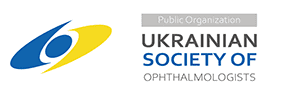Role of IL6 -174 G/C, IL10 1082G/A and IL10 -592C/A in the pathogenesis of keratoconus and development of recurrent erosion in Ukrainian patients with lattice corneal dystrophy
DOI:
https://doi.org/10.31288/oftalmolzh20202311Keywords:
keratoconus, lattice corneal dystrophy, recurrent erosions, clinical phenotype, interleukin gene polymorphism, genetic predispositionAbstract
Background: Keratoconus (KC, or corneal ectasia) is a multifactorial disease with a genetic component and an average annual incidence rate of 2.0/100,000 persons. Lattice corneal stromal dystrophy (LCD), a monogenic disorder with varying phenotypic manifestations, is the most common hereditary corneal dystrophy associated with mutations in the TGFBI gene in Ukraine, with as much as 40.2% of cases attributed to this disease.
Purpose: To elucidate the role of polymorphic variants in the IL6 promoter (-174 G/C) and IL10 (-1082G/A and -592C/A) as factors of a genetic predisposition to KC and recurrent corneal erosion in Ukrainian patients with LCD.
Material and Methods: All patients underwent a routine eye examination including visual acuity assessment, biomicroscopy, fluorescein testing, tonometry and ophthalmoscopy. In addition, patients with KC underwent keratotopography, pachymetry, remote biometry and gonioscopy. Genotyping was done for IL6 -174 G/C, IL10 -1082G/A and IL10 -592C/A by polymerase chain reaction followed by restriction fragment length polymorphism. Fexact test was used for statistical analyses.
Results: The frequency of homozygotes (AA) for IL10 rs1800896 was increased, whereas the frequency of homozygotes (CC) for IL6 174G/С was decreased in patients with KC compared to controls (0.25 vs 0.19 and 0.18 vs 0.22, respectively), although the differences were not statistically significant. The frequency of IL6 C allele carriers was significantly higher among patients with LCD and recurrent corneal erosion than controls (0.78 vs 0.66, respectively; p < 0.05). There was a statistically significant difference in the proportion of carriers of the IL10 -592A allele between patients with recurrent corneal erosion and population sample (0.483 vs 0.327, respectively, p < 0.05).
Conclusion: IL6 174G/С, IL10 -592С/A and IL10 -1082G/C and the genes determining the pathological processes in the cornea produce a cumulative effect towards modifying the clinical phenotype in keratoconus and lattice corneal dystrophy.
References
1.Kennedy RH, Bourne WM, Dyer JA. A 48-year clinical and epidemiologic study of keratoconus. Am J Ophthalmol. 1986 Mar 15;101(3):267-73. https://doi.org/10.1016/0002-9394(86)90817-2
2.Dronov MM, Pirogov IuI. [Keratoconus: Types, Etiology and Pathogenesis. Part 1]. Oftalmokhirurgiia i terapiia. 2002;2:33-7. Russian.
3.Sevost'ianov EN, Gorskova EN, Ekgardt VF. [Keratoconus (ethiology, pathogenesis, and medicinal treatment): a tutorial]. Cheliabinsk: UGMADO; 2005. Russian.
4.Birich TA, Chekina AIu, Aksenova NI. [Treatment outcomes for patients with keratoconus]. Oftalmologiia Belarusi. 2010;1(4). Russian.
5.Nowak DM, Gajecka M. The genetics of keratoconus. Middle East Afr J Ophthalmol. 2011 Jan;18(1):2-6.https://doi.org/10.4103/0974-9233.75876
6.Karimian F, Aramesh S, Rabei HM, Javadi MA, Rafati N. Topographic evaluation of relatives of patients with keratoconus. Cornea. 2008 Sep;27(8):874-8.https://doi.org/10.1097/ICO.0b013e31816f5edc
7.Owens H, Gamble G. A profile of keratoconus in New Zealand. Cornea. 2003;22:122-25.https://doi.org/10.1097/00003226-200303000-00008
8.Aknin C, Allart JF, Rouland JF. [Unilateral keratoconus and mirror image in a pair of monozygotic twins]. J Fr Ophtalmol. 2007 Nov;30(9):899-902.https://doi.org/10.1016/S0181-5512(07)74025-1
9.Weed KH, MacEwen CJ, McGhee CN. The variable expression of keratoconus within monozygotic twins: dundee University Scottish Keratoconus Study (DUSKS). Cont Lens Anterior Eye. 2006 Jul;29(3):123-6.https://doi.org/10.1016/j.clae.2006.03.003
10.Schmitt-Bernard C, Schneider CD, Blanc D, Arnaud B. Keratographic analysis of a family with keratoconus in identical twins. J Cataract Refract Surg. 2000 Dec;26(12):1830-2.https://doi.org/10.1016/S0886-3350(00)00556-3
11.Parker J, Ko WW, Pavlopoulos G, Wolfe PJ, Rabinowitz YS, et al. Videokeratography of keratoconus in monozygotic twins. J Refract Surg. 1996 Jan-Feb;12(1):180-3.https://doi.org/10.3928/1081-597X-19960101-31
12.Hughes AE, Dash DP, Jackson AJ, Frazer DG, Silvestri G. Familial keratoconus with cataract: linkage to the long arm of chromosome 15 and exclusion of candidate genes. Invest Ophthalmol Vis Sci. 2003 Dec;44(12):5063-6.https://doi.org/10.1167/iovs.03-0399
13.Rabinowitz YS. The genetics of keratoconus. Ophthalmol Clin North Am. 2003 Dec;16(4):607-20, vii.https://doi.org/10.1016/S0896-1549(03)00099-3
14.Wheeler J, Hauser MA, Afshari NA, Allingham RR, Liu Y. The Genetics of Keratoconus: A Review. Reprod Syst Sex Disord. 2012 Jun 3;(Suppl 6).
15.Dimasi DP, Burdon KP, Craig JE. The genetics of central corneal thickness. Br J Ophthalmol. 2010 Aug;94(8):971-6.https://doi.org/10.1136/bjo.2009.162735
16.Pedersen U, Bramsen T. Central corneal thickness in osteogenesis imperfecta and otosclerosis. ORL J Otorhinolaryngol Relat Spec. 1984;46(1):38-41.https://doi.org/10.1159/000275682
17.Evereklioglu C, Madenci E, Bayazit YA, et al. Central corneal thickness is lower in osteogenesis imperfecta and negatively correlates with the presence of blue sclera. Ophthalmic Physiol Opt. 2002 Nov;22(6):511-5.https://doi.org/10.1046/j.1475-1313.2002.00062.x
18.Cohen EJ, Myers JS. Keratoconus and normal-tension glaucoma: a study of the possible association with abnormal biomechanical properties as measured by corneal hysteresis. Cornea. 2010 Sep;29(9):955-70.https://doi.org/10.1097/ICO.0b013e3181ca363c
19.Gordon M.O, et al. The Ocular Hypertension Treatment Study: baseline factors that predict the onset of primary open-angle glaucoma. Arch Ophthalmol. 2002 Jun;120(6):714-20; discussion 829-30.https://doi.org/10.1001/archopht.120.6.714
20.Cornes BK, Khor CC, Nongpiur MI, et al. Identification of four novel variants that influence central corneal thickness in multi-ethnic Asian populations. Hum Mol Genet. 2012 Jan 15;21(2):437-45.https://doi.org/10.1093/hmg/ddr463
21.Lu Y, Dimasi DP, Hysi PG, et al. Common genetic variants near the Brittle Cornea Syndrome locus ZNF469 influence the blinding disease risk factor central corneal thickness. PLoS Genet. 2010 May 13;6(5):e1000947.https://doi.org/10.1371/journal.pgen.1000947
22.Vitart V, Benci? G, Hayward C, et al. New loci associated with central cornea thickness include COL5A1, AKAP13 and AVGR8. Hum Mol Genet. 2010 Nov 1;19(21):4304-11.https://doi.org/10.1093/hmg/ddq349
23.Vithana EN, Aung T, Khor CC, et al. Collagen-related genes influence the glaucoma risk factor, central corneal thickness. Hum Mol Genet. 2011 Feb 15;20(4):649-58.https://doi.org/10.1093/hmg/ddq511
24.Burdon KP, Macgregor S, Bykhovskaya Y, et al. Association of Polymorphisms in the Hepatocyte Growth Factor Gene Promoter with Keratoconus. Invest Ophthalmol Vis Sci. 2011 Oct 31;52(11):8514-9.https://doi.org/10.1167/iovs.11-8261
25.Chwa M, Atilano SR, Reddy V, Jordan N, Kim DW, Kenney MC. Increased stress-induced generation of reactive oxygen species and apoptosis in human keratoconus fibroblasts. Invest Ophthalmol Vis Sci. 2006 May;47(5):1902-10.https://doi.org/10.1167/iovs.05-0828
26.Balasubramanian SA, Mohan S, Pye DC, Willcox MD. Proteases, proteolysis and inflammatory molecules in the tears of people with keratoconus. Acta Ophthalmol. 2012 Jun;90(4):e303-9.https://doi.org/10.1111/j.1755-3768.2011.02369.x
27.Lema I, Duran JA. Inflammatory molecules in the tears of patients with keratoconus. Ophthalmology. 2005 Apr;112(4):654-9.https://doi.org/10.1016/j.ophtha.2004.11.050
28.Lema I, Sobrino T, Duran JA, Brea D, Diez-Feijoo E. Subclinical keratoconus and inflammatory molecules from tears. Br J Ophthalmol. 2009 Jun;93(6):820-4.https://doi.org/10.1136/bjo.2008.144253
29.Nemet AY, Vinker S, Bahar I, Kaiserman I. The association of keratoconus with immune disorders. Cornea. 2010 Nov;29(11):1261-4.https://doi.org/10.1097/ICO.0b013e3181cb410b
30.Wisse RP, Kuiper JJ, Gans R, Imhof S, Radstake TR, Van der Lelij A. Cytokine expression in keratoconus and its corneal microenvironment: a systematic review. Ocular Surf. 2015 Oct;13(4):272-83.https://doi.org/10.1016/j.jtos.2015.04.006
31.Jun AS, Cope L, Speck C, et al. Subnormal cytokine profile in the tear fluid of keratoconus patients. PLoS One. 2011 Jan 27;6(1):e16437.https://doi.org/10.1371/journal.pone.0016437
32.Temple S, Lim E, Cheong K, et al. Alleles carried at positions ?819 and ?592 of the IL10 promoter affect transcription following stimulation of peripheral blood cells with Streptococcus pneumoniae. Immunogenetics. 2003;55:629-32.https://doi.org/10.1007/s00251-003-0621-6
33.Costa GC, da Costa Rocha MO, Moreira PR, et al. Functional IL-10 Gene Polymorphism Is Associated with Chagas Disease Cardiomyopathy. J Infect Dis. 2009 Feb 1;199(3):451-4.https://doi.org/10.1086/596061
34.Agrawal VB, Tsai RJ. Corneal epithelial wound healing. Indian J Ophthalmol. 2003 Mar;51(1):5-15.
35.Wilson SE, Mohan RR, Ambr?sio R, et al. The corneal wound healing response: cytokine-mediated interaction of the epithelium, stroma, and inflammatory cells. Prog Retin Eye Res. 2001 Sep;20(5):625-37.https://doi.org/10.1016/S1350-9462(01)00008-8
36.Ebihara N, Matsuda A, Nakamura S, et al. Role of the IL-6 classic- and trans-signaling pathways in corneal sterile inflammation and wound healing. Invest Ophthalmol Vis Sci. 2011 Nov 1;52(12):8549-57.https://doi.org/10.1167/iovs.11-7956
37.Sotozono C, He J, Matsumoto Y, et al. Cytokine expression in the alkali-burned cornea. Curr Eye Res. 1997 Jul;16(7):670-6.https://doi.org/10.1076/ceyr.16.7.670.5057
38.Ferrari SL, Ahn-Luong L, Garnero P, et al. Two promoter polymorphisms regulating interleukin-6 gene expression are associated with circulating levels of C-reactive protein and markers of bone resorption in postmenopausal women. J Clin Endocrinol Metab. 2003 Jan;88(1):255-9.https://doi.org/10.1210/jc.2002-020092
39.Fishman D, Faulds G, Jeffery R, et al. The effect of novel polymorphisms in the interleukin-6 (IL-6) gene on IL-6 transcription and plasma IL-6 levels, and an association with systemic-onset juvenile chronic arthritis. J Clin Invest. 1998 Oct 1;102(7):1369-76.https://doi.org/10.1172/JCI2629
40.Kristiansen OP, Nols?e RL, Larsen L, et al. Association of a functional 17beta-estradiol sensitive IL6-174G/C promoter polymorphism with early-onset type 1 diabetes in females. Hum Mol Genet. 2003 May 15;12(10):1101-10.https://doi.org/10.1093/hmg/ddg132
41.Kucherenko AM, Pampukha VM, Drozhzhyna GI, Livshits LA. IL1beta, IL6 and IL8 gene polymorphisms involvement in recurrent corneal erosion in patients with hereditary stromal corneal dystrophies. Tsitol Genet. 2013 May-Jun;47(3):42-5.https://doi.org/10.3103/S0095452713030055
42.Yi Lu, Vitart V, Burdon KP, et al. Genome-wide association analyses identify multiple loci associated with central corneal thickness and keratoconus. Nat Genet. 2013 Feb;45(2):155-63.
43.Aldave A. The genetics of the corneal dystrophies. Dev Ophthalmol. 2011. 2011;48:51-66.https://doi.org/10.1159/000324077
44.Kannabiran C, Klintworth GK. TGFBI gene mutations in corneal dystrophies. Hum Mutat. 2006 Jul;27(7):615-25.https://doi.org/10.1002/humu.20334
45.Pampukha VM, Drozhyna GI, Livshits LA. TGFBI gene mutation analysis in families with hereditary corneal dystrophies from Ukraine. Ophthalmologica. 2004 Nov-Dec;218(6):411-4.https://doi.org/10.1159/000080945
46.Weidle E. Epithelial and stromal corneal dystrophies. Ophthalmologe. 1996; 93(6):754-67.
47.Reinach P, Pokorny PS. The corneal epithelium: clinical relevance of cytokine-mediated responses to maintenance of corneal health. Arq Bras Oftalmol. 2008 Nov-Dec;71(6 Suppl):80-6.https://doi.org/10.1590/S0004-27492008000700016
48.Hong JW, Liu JJ, Lee JS, et al. Proinflammatory chemokine induction in keratocytes and inflammatory cell infiltration into the cornea. Invest Ophthalmol Vis Sci. 2001 Nov;42(12):2795-803.
49.Torres P, Kijlstra A. The role of cytokines in corneal immunopathology. Ocul Immunol Inflamm. 2001 Mar;9(1):9-24.https://doi.org/10.1076/ocii.9.1.9.3978
Downloads
Published
How to Cite
Issue
Section
License
Copyright (c) 2025 Л. А. Лівшиць, Г. І. Дрожжина, А. М. Кучеренко, О. В. Івановська, Т. Б. Гайдамака, О. В. Городна, К. В. Середа

This work is licensed under a Creative Commons Attribution 4.0 International License.
This work is licensed under a Creative Commons Attribution 4.0 International (CC BY 4.0) that allows users to read, download, copy, distribute, print, search, or link to the full texts of the articles, or use them for any other lawful purpose, without asking prior permission from the publisher or the author as long as they cite the source.
COPYRIGHT NOTICE
Authors who publish in this journal agree to the following terms:
- Authors hold copyright immediately after publication of their works and retain publishing rights without any restrictions.
- The copyright commencement date complies the publication date of the issue, where the article is included in.
DEPOSIT POLICY
- Authors are permitted and encouraged to post their work online (e.g., in institutional repositories or on their website) during the editorial process, as it can lead to productive exchanges, as well as earlier and greater citation of published work.
- Authors are able to enter into separate, additional contractual arrangements for the non-exclusive distribution of the journal's published version of the work with an acknowledgement of its initial publication in this journal.
- Post-print (post-refereeing manuscript version) and publisher's PDF-version self-archiving is allowed.
- Archiving the pre-print (pre-refereeing manuscript version) not allowed.












